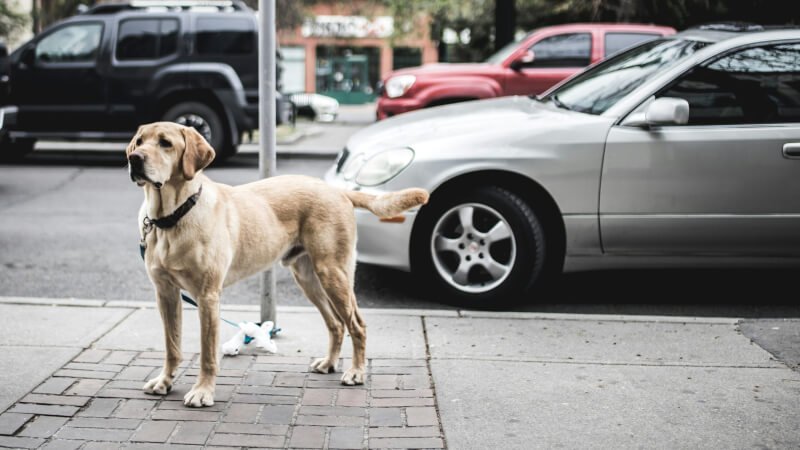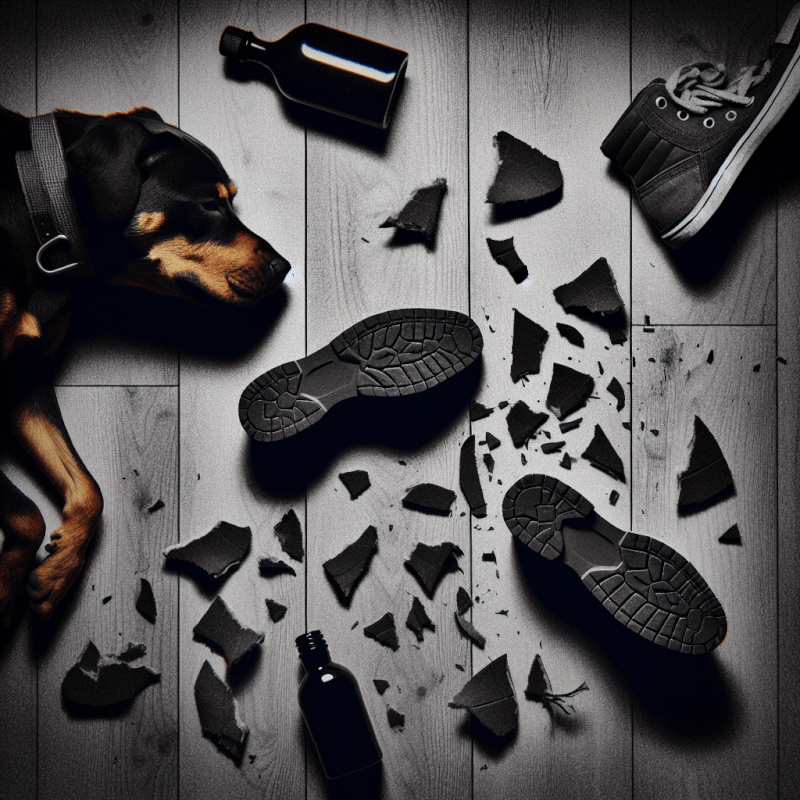You’ve just brought home a furry bundle of joy, but as the days go by, your once angelic puppy has turned into a tornado of destruction. From chewed shoes to scratched furniture, you’re at your wit’s end trying to curb your dog’s destructive behavior. But fear not, because in this article, we’ll explore effective techniques and tips to help transform your little menace into a well-behaved canine companion. Get ready to say goodbye to torn upholstery and hello to a harmonious home with your furry friend.

Understanding Destructive Behavior
Destructive behavior in dogs can be frustrating and challenging for both the owner and the dog. It is important to understand the underlying causes of such behavior in order to effectively address and prevent it. There are several factors that can contribute to destructive behavior in dogs, including boredom, anxiety, lack of exercise, and lack of mental stimulation. By identifying and addressing these root causes, you can help your dog overcome destructive behavior and create a more harmonious environment for both of you.
Ready for Cat Trivia?
Test your knowledge about cats!

Causes of Destructive Behavior
Destructive behavior in dogs can be caused by a variety of factors. One of the most common causes is boredom. Dogs are intelligent creatures that require mental stimulation to prevent boredom, and when they lack this stimulation, they may resort to destructive behaviors such as chewing on furniture or digging up the yard.
Another common cause of destructive behavior is anxiety. Dogs, just like humans, can experience anxiety and may exhibit destructive behaviors as a way to cope with their feelings of stress or fear. Separation anxiety, for example, can cause a dog to chew on furniture or bark excessively when left alone.
Lack of exercise can also contribute to destructive behavior in dogs. Dogs are naturally active animals and need regular physical activity to burn off energy. Without sufficient exercise, dogs may become restless and engage in destructive behaviors out of frustration or boredom.
Common Destructive Behaviors in Dogs
There are several common destructive behaviors that dogs may exhibit. Chewing and destructive biting are among the most prevalent. Dogs may chew on furniture, shoes, or other household items as a way to alleviate boredom or anxiety.
Digging and scratching are other destructive behaviors that dogs may engage in. Dogs may dig up the yard or scratch at doors or walls out of frustration or to escape from a confined space.
Excessive barking is another common behavior that can be destructive, both for the dog and for the owner. Dogs may bark excessively due to boredom, anxiety, or in response to external stimuli, such as other dogs or noises.
Separation anxiety is a specific type of destructive behavior that occurs when a dog becomes anxious or stressed when separated from their owner. Dogs with separation anxiety may engage in destructive behaviors, such as chewing on furniture or excessive barking, when left alone.
Aggressive behavior is another form of destructive behavior that can be dangerous and harmful. Aggression can be directed towards other animals, humans, or even objects, and can result in injury or property damage.
The Impact of Destructive Behavior on Dogs and Owners
Destructive behavior can have a significant impact on both dogs and their owners. For dogs, engaging in destructive behaviors can be a sign of underlying anxiety, boredom, or other emotional distress. This behavior can result in physical harm to the dog, such as injury from chewing on objects, or it can lead to negative consequences such as being rehomed or surrendered to a shelter.
For owners, dealing with destructive behavior can be frustrating and overwhelming. It can result in damaged property, increased stress levels, and strained relationships with neighbors or landlords. Additionally, the emotional toll of witnessing a beloved pet engage in destructive behaviors can take a toll on the owner’s mental well-being.

Preventing Destructive Behavior
Preventing destructive behavior in dogs is crucial for creating a harmonious and stress-free environment for both the owner and the pet. There are several key strategies that can help in preventing destructive behavior:
Establishing a Routine and Providing Structure
Dogs thrive on routine and structure, and this can help prevent destructive behavior. By establishing a consistent daily routine for your dog, including regular feeding times, exercise sessions, and playtime, you can provide them with a sense of stability and reduce their likelihood of engaging in destructive behaviors.
Providing Adequate Exercise and Mental Stimulation
Regular exercise and mental stimulation are essential for preventing destructive behavior in dogs. Dogs need both physical and mental outlets to burn off energy and satisfy their natural instincts. Providing daily exercise, such as walks or playtime in a fenced yard, can help prevent boredom and restlessness that may lead to destructive behaviors. Additionally, engaging in activities that stimulate the dog’s mind, such as puzzle toys or training sessions, can help keep their minds occupied and prevent boredom-related destructive behaviors.
Managing Stress and Anxiety
Addressing and managing your dog’s stress and anxiety is crucial for preventing destructive behavior. There are various techniques that can help reduce anxiety in dogs, such as providing a safe and quiet space for them to retreat to, using calming aids like pheromone diffusers, or playing soothing music. Additionally, it is important to gradually expose your dog to new environments and experiences in a positive and controlled manner to help them build confidence and reduce anxiety.
Creating a Safe and Enriched Environment
Creating a safe and enriched environment for your dog can help prevent destructive behavior. This includes puppy-proofing your home by removing any items that could be potentially dangerous or tempting for the dog to chew on. Providing appropriate chew toys and interactive puzzle toys can also help redirect their chewing behavior onto acceptable items. Creating a comfortable and secure space for your dog, such as a crate or designated area, can also help prevent anxiety-related destructive behaviors.
Positive Reinforcement and Dog Training
Positive reinforcement training is a highly effective and ethical approach to training dogs and addressing destructive behavior. This training method focuses on rewarding desired behaviors rather than punishing unwanted behaviors. By using positive reinforcement, you can establish a strong bond with your dog and motivate them to behave in a desired manner.
Understanding Positive Reinforcement Training
Positive reinforcement training involves rewarding your dog for exhibiting the desired behavior. This can be done by offering treats, praise, or a favorite toy. By consistently rewarding your dog for good behavior, you can reinforce those behaviors and encourage them to continue behaving in a positive manner.
Using Rewards and Treats Effectively
Using rewards and treats effectively is a key aspect of positive reinforcement training. It is important to use high-value treats that your dog finds motivating and rewarding. Rewarding your dog immediately after they exhibit the desired behavior is also crucial for them to associate the behavior with the reward. Gradually reducing the frequency of treats as the behavior becomes more consistent is also important to ensure long-term success.
Avoiding Punishment-Based Training
Punishment-based training methods, such as physical corrections or yelling, can have negative consequences and may exacerbate destructive behavior in dogs. Punishment can lead to fear, anxiety, and even aggression in dogs. Positive reinforcement training focuses on rewarding desired behaviors rather than punishing unwanted behaviors, creating a positive and effective training experience.
Seeking Professional Help for Training
For complex or persistent destructive behaviors, seeking professional help from a certified dog trainer or behaviorist may be beneficial. These professionals can assess the underlying causes of the destructive behavior and provide customized training plans and behavior modification techniques to address the issue effectively. They can also provide guidance and support for owners in implementing training strategies and managing the behavior of their dogs.

Addressing Specific Destructive Behaviors
Specific destructive behaviors require targeted training techniques to effectively address them. Here are some common destructive behaviors and techniques for addressing them:
Chewing and Destructive Biting
Chewing and destructive biting can be addressed by providing appropriate chew toys and redirecting the behavior onto those toys. Teaching the “leave it” and “drop it” commands can also be helpful in preventing the dog from chewing on inappropriate items.
Digging and Scratching
To address digging and scratching behavior, providing designated digging areas or sandboxes can redirect the behavior onto acceptable surfaces. Additionally, increasing exercise and mental stimulation can help prevent boredom-related digging and scratching.
Excessive Barking
Excessive barking can be addressed by identifying the underlying cause, such as boredom or anxiety, and addressing it appropriately. Engaging the dog in mental enrichment activities and providing them with interactive toys can also help redirect their focus and reduce excessive barking.
Separation Anxiety
Separation anxiety requires a comprehensive approach to address. Gradually desensitizing the dog to being alone, providing them with interactive toys or puzzle toys to keep them occupied, and practicing short separations can help them become more comfortable and reduce anxiety-related destructive behaviors.
Aggressive Behavior
Aggressive behavior requires professional help from a certified dog trainer or behaviorist. They can assess the underlying causes of the aggression and provide a tailored training plan to address the issue safely and effectively.
Training Techniques for Addressing Destructive Behavior
Several training techniques can be employed to address destructive behavior effectively:
Redirecting and Offering Alternatives
When you catch your dog engaging in destructive behavior, such as chewing on furniture, redirect their attention to an appropriate chew toy or interactive toy. By offering alternatives, you can teach your dog what is acceptable to chew on and redirect their destructive behavior.
Teaching the ‘Leave it’ and ‘Drop it’ Commands
Teaching the “leave it” and “drop it” commands can be incredibly useful in preventing destructive behavior. These commands teach your dog to let go of an object or to leave it alone, helping to prevent them from engaging in destructive behaviors like chewing or biting.
Using Crate Training for Management
Crate training can be an effective management tool to prevent destructive behaviors when you are unable to supervise your dog. When done correctly, a crate provides a safe and secure space for your dog to relax in and reduces the likelihood of them engaging in destructive behaviors.
Desensitization and Counter Conditioning
For dogs with anxiety-related destructive behaviors, desensitization and counter-conditioning techniques can be helpful. These techniques involve gradually exposing the dog to the triggers that cause anxiety while simultaneously providing positive reinforcement, such as treats or praise, to create positive associations and reduce fear or anxiety.
Clicker Training for Positive Associations
Clicker training is a positive reinforcement technique that uses a clicking sound to mark desired behaviors. By pairing the clicker sound with a reward, such as treats or praise, you can create positive associations with the desired behaviors and reinforce them effectively.

Developing Consistency and Patience
Consistency and patience are key when addressing and preventing destructive behavior in dogs. Establishing clear rules and boundaries, being consistent in training methods, and managing expectations are essential for long-term success.
Establishing Clear Rules and Boundaries
Setting clear rules and boundaries for your dog helps provide structure and guidance, preventing confusion and frustration. Consistently enforcing these rules and boundaries helps your dog understand what is expected of them and reduces the likelihood of engaging in destructive behaviors.
Consistency in Training Methods
Using consistent training methods throughout the training process is important. Inconsistency can confuse the dog and hinder their progress. By using the same techniques and commands consistently, you can help your dog understand and respond to the training more effectively.
Managing Expectations and Being Patient
Addressing and preventing destructive behavior takes time and patience. It is important to manage your expectations and understand that progress may be gradual. Celebrate small victories and be patient with your dog as they learn and grow.
Troubleshooting Challenges in Training
Addressing destructive behavior can sometimes present challenges, but there are ways to troubleshoot and overcome them.
Identifying the Root Cause of Destructive Behavior
Identifying the underlying cause of the destructive behavior is crucial for effective training. If your training methods don’t seem to be working, reassessing the root cause, such as anxiety or lack of exercise, can help you adjust your training approach accordingly.
Modifying Training Techniques When Needed
Not all dogs respond the same way to training techniques. If a particular technique doesn’t seem to be working for your dog, it may be necessary to modify or try different approaches. Consulting with a professional dog trainer or behaviorist can provide valuable guidance in determining the most appropriate training techniques for your dog.
Seeking Professional Guidance for Complex Behavior Problems
For complex or persistent destructive behaviors, seeking professional guidance from a certified dog trainer or behaviorist is highly recommended. They have the knowledge and expertise to assess the situation accurately and provide a tailored training plan to address the issue effectively.

The Role of Exercise and Mental Stimulation
Exercise and mental stimulation play a vital role in preventing destructive behavior in dogs. Regular exercise and engaging activities help burn off excess energy and satisfy their natural instincts, reducing the likelihood of engaging in destructive behaviors.
Finding the Right Exercise Routine
Finding the right exercise routine for your dog is essential. The amount and type of exercise your dog needs can vary depending on their age, breed, and overall health. Consult with your veterinarian or a professional dog trainer to determine the appropriate exercise routine for your dog.
Enrichment Activities for Mental Stimulation
Mental stimulation is just as important as physical exercise. Engaging your dog in activities that challenge their mind, such as puzzle toys, scent games, or obedience training, can help prevent boredom and destructive behaviors.
Combining Physical and Mental Exercise
Combining physical and mental exercise can provide a well-rounded approach to preventing destructive behavior. Taking your dog for a walk, followed by a training session or playing with interactive toys, can help burn off energy and stimulate their mind.
The Importance of Socialization
Proper socialization is crucial for preventing destructive behavior and fostering a well-behaved and balanced dog.
Properly Socializing Dogs from an Early Age
Socializing dogs from a young age allows them to develop positive associations with various environments, people, and other animals. Exposing them to different situations and stimuli in a controlled and positive manner helps reduce anxiety-related destructive behaviors.
Exposing Dogs to Various Environments and Stimuli
Continued exposure to various environments and stimuli is important to prevent fear or anxiety-related destructive behaviors. Gradually exposing your dog to new situations, such as different types of sounds or environments, can help build their confidence and reduce their likelihood of engaging in destructive behaviors.
Positive Reinforcement during Socialization
Using positive reinforcement techniques during socialization helps create positive associations with new experiences. Rewarding your dog for calm and appropriate behaviors during socialization can help reinforce positive behavior and reduce the chance of destructive behaviors.
Maintaining a Healthy and Balanced Lifestyle
Maintaining a healthy and balanced lifestyle is essential for preventing destructive behavior in dogs. Here are some key factors to consider:
Providing a Balanced Diet
A balanced and nutritious diet is crucial for your dog’s overall health and well-being. Consult with your veterinarian to develop a diet plan that suits your dog’s specific needs. A healthy diet can contribute to balanced behavior and prevent health-related issues that may contribute to destructive behaviors.
Regular Veterinary Check-ups
Regular veterinary check-ups are important to ensure your dog’s physical health. Physical discomfort or underlying health conditions can contribute to anxiety or restlessness, which may manifest as destructive behaviors. Routine check-ups can help identify and address any medical issues that may be contributing to destructive behavior.
Addressing Other Factors Influencing Behavior
Destructive behavior in dogs can sometimes be influenced by factors beyond training and exercise. Factors such as environmental changes, changes in the household dynamic, or underlying medical conditions can contribute to destructive behavior. Consider any changes or factors that may be affecting your dog’s behavior and address them appropriately.
By understanding the causes and prevention strategies for destructive behavior in dogs, as well as implementing positive reinforcement training techniques and maintaining a healthy and balanced lifestyle, you can create a harmonious and stress-free environment for your furry friend. Remember to be patient and consistent in your approach, and seek professional help when needed. Together, you and your dog can overcome destructive behavior and strengthen your bond.


